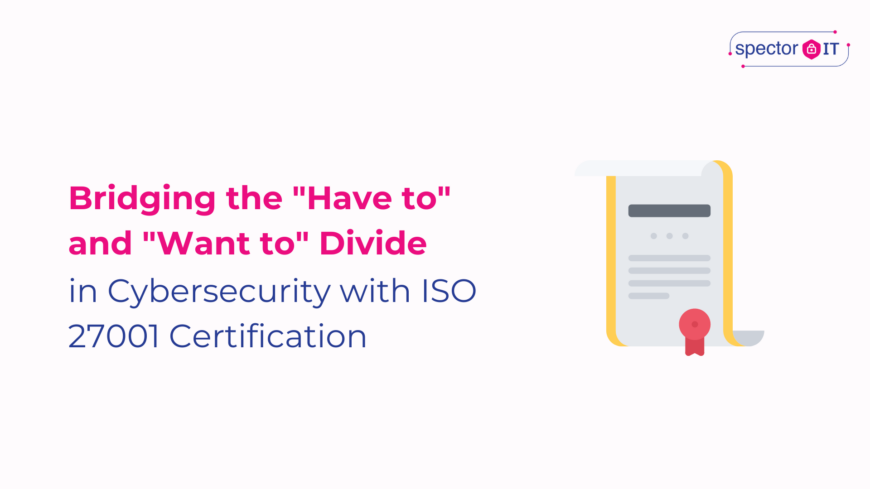
Bridging the “Have to” and “Want to” Divide in Cybersecurity with ISO 27001 Certification
In the complex landscape of cybersecurity, where threats loom large and data breaches can cripple businesses, ensuring robust IT security isn’t just a precaution—it’s a necessity. However, aligning the priorities and perspectives of IT teams with those of C-level executives can be challenging. There exists a fundamental divide in many organisations, often referred to as the “have to” versus “want to” divide in cybersecurity. This gap can lead to misalignment, communication gaps, and ultimately, vulnerabilities in cybersecurity measures.
Understanding the “Have to” and “Want to” Divide in ISO 27001 Certification
The “have to” element typically stems from a sense of duty, necessity, or external coercion. In the context of cybersecurity, it often manifests as actions taken to comply with regulations, avoid penalties, or meet minimum standards. It’s a reactive approach, driven by the fear of consequences rather than a proactive commitment.
Conversely, the “want to” approach is driven by internal motivation, such as personal values, goals, or a genuine understanding of the benefits of robust cybersecurity. This proactive stance not only aligns with the organisation’s strategic goals but also fosters a culture of security and resilience.
The Role of C-Level Executives and IT Teams
A common scenario in many organisations is a disconnect between C-level executives and IT teams. IT professionals may feel that their C-level counterparts do not fully comprehend the critical nature of cybersecurity. On the other hand, C-level executives often view IT teams as cost centres, constantly demanding more resources without considering broader financial implications.
This misalignment can create significant challenges in adequately securing an organisation. Without a unified approach, cybersecurity measures may be inconsistent, leaving the organisation vulnerable to attacks.
ISO 27001: A Framework to Bridge the Divide
ISO 27001, a leading international standard for information security management, offers a comprehensive framework that can help bridge the “have to” and “want to” divide. By adopting ISO 27001, organisations can systematically examine their information security risks, including threats, vulnerabilities, and impacts, and implement a coherent and comprehensive suite of information security controls and risk management practices.
Enhanced Information Security
Implementing ISO 27001 helps protect sensitive information, intellectual property, and customer data, thereby safeguarding an organisation’s reputation. This is not merely about avoiding negative outcomes; it’s about actively pursuing a secure operational environment.
Improved Client Confidence
Certification fosters trust with clients and partners, particularly those handling sensitive data. In industries where data security is paramount, being ISO 27001 certified can give a significant competitive edge in securing contracts and attracting new clients.
Reduced Operational Costs
By preventing data breaches and cyberattacks, organisations save on the costs associated with data recovery, forensic investigations, and reputational repair. A proactive approach to information security minimises these risks, reducing unexpected expenditures.
Competitive Advantage
Demonstrating a commitment to information security distinguishes a company from its competitors. Certification enhances the brand image and positions the company as a security-conscious organisation, which can be a decisive factor for potential clients.
Improved Business Continuity
Certified companies have robust disaster recovery planning in place, ensuring business continuity in the event of a cybersecurity incident. This preparedness is crucial for maintaining operations under adverse conditions.
Increased Employee Awareness
The process of implementing ISO 27001 raises awareness of information security risks among employees. This empowerment encourages them to adopt secure practices and contribute to the overall security posture of the organisation.
Realising Business Gains Through ISO 27001
Adopting ISO 27001 can help align the objectives of C-level executives and IT departments. The certification process is not just about meeting an external standard but about realising real business gains. Through this process, both parties come to understand and appreciate the tangible benefits of enhanced cybersecurity measures.
A goal such as ISO 27001 certification can alleviate the tensions between the need to comply (“have to”) and the desire to protect (“want to”). It allows both C-level executives and IT teams to see beyond the cost and perceive the value in investment, driving a more unified approach to cybersecurity.
Conclusion
In the complex interplay of business operations and cybersecurity threats, ISO 27001 emerges as a critical tool that can bridge the divide between “have to” and “want to.” By fostering a shared understanding and commitment to cybersecurity, organisations can not only protect themselves from immediate threats but also build a resilient and secure foundation for future growth. Embracing ISO 27001 is not just about achieving certification; it’s about adopting a mindset that values security as an integral part of business success—a true win/win situation for all stakeholders involved.
Contact us today to schedule a no-commitment Discovery Call to discuss how we can help you strategize your cybersecurity roadmap with ISO 27001 certification and get your company ready for the future while ensuring compliance with the industry standards.
Many thanks for reading! To learn more about Business Technology, read our blogs.

